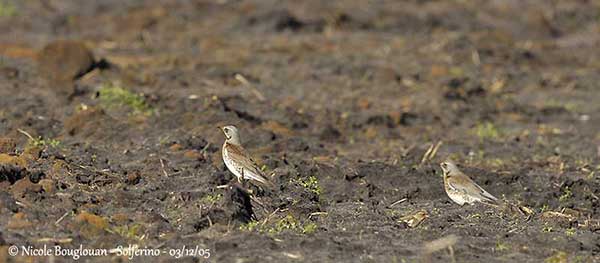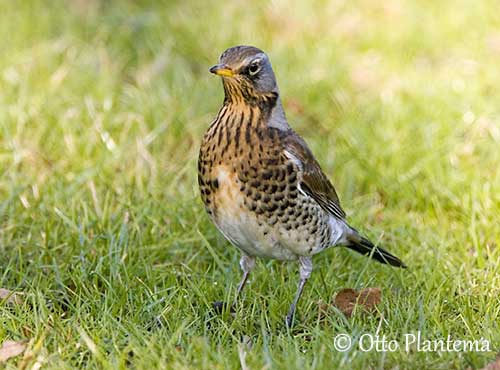
Fr: Grive litorne
Ang: Fieldfare
All: Wacholderdrossel
Esp: Zorzal Real
Ita: Cesena
Nd: Kramsvogel
Sd: Björktrast
Photographers:
John Anderson
John Anderson Photo Galleries
Jean Michel Fenerole
Photos d’Oiseaux du monde
Otto Plantema
Trips around the world
Ingo Waschkies
My bird pictures on Pbase
Nicole Bouglouan
PHOTOGRAPHIC RAMBLE
Text by Nicole Bouglouan
Sources:
HANDBOOK OF THE BIRDS OF THE WORLD Vol 10 by Josep del Hoyo-Andrew Elliott-David Christie - Lynx Edicions - ISBN: 8487334725
THRUSHES by Peter Clement and Ren Hathway – HELM - ISBN: 0713639407
THE HANDBOOK OF BIRD IDENTIFICATION FOR EUROPE AND THE WESTERN PALEARCTIC by Mark Beaman, Steve Madge - C. Helm - ISBN: 0713639601
THE COMPLETE BOOK OF BRITISH BIRDS – Written by “Royal Society for the Protection of Birds” experts - Préface de Magnus Magnusson - Michael Cady- Rob Hume Editors - ISBN: 0749509112
NEST DEFENCE STRATEGIES IN FIELDFARES by Olav Hogstad
Birds of Britain - The Web Magazine for Birdwatchers
What Bird-The ultimate Bird Guide (Mitchell Waite)
Pájaros de España (JL Beamonte)
Fieldfare
Turdus pilaris
Passeriformes Order – Turdidae Family
INTRODUCTION:
The Fieldfare is a conspicuous forest thrush during the breeding season, but it prefers open country during winter. This Turdidae is a beautiful combination of grey head and rump and reddish-brown mantle, making this bird very similar to its environment.
Frequently seen in flocks or loose groups, even when breeding, the Fieldfares are very vocal. However, their song lacks the clear and fluty notes of the Common Blackbird.
The Fieldfare is migratory. It breeds from Iceland to NW China and winters in S Europe and SW Asia. This species is monotypic and its population is currently stable.

DESCRIPTION OF THE BIRD:
Biometrics:
Length: 24-28 cm
Wingspan: 39-42 cm
Weight: 80-140 g
The Fieldfare adult has deep chestnut mantle, back and scapulars, with some feathers showing paler edges. Rump and uppertail-coverts are grey. The uppertail is dark, black to brownish-black. The flight feathers are black, usually with pale edges.
On the white underparts, the breast shows orange-buff wash with conspicuous black streaks, whereas the flanks are tinged buff with black spots. The underwing-coverts are white.
The head is bluish-grey from forehead to nape, and finely streaked black. Lores, cheeks, malar and neck patches are blackish. We can see a whitish supercilium. The chin is whitish with pale orange-buff wash and narrow black streaks, especially on lower and sides of throat.
The bill is yellow with black tip. The eyes are dark brown, surrounded by narrow, feathered, white eyering. Legs and feet are blackish-brown.
The female resembles male but with less streaking on crown, duller rufous parts and mostly dark brownish-olive tail. On the underparts, the flank pattern is less distinct. The bill is duller yellow.
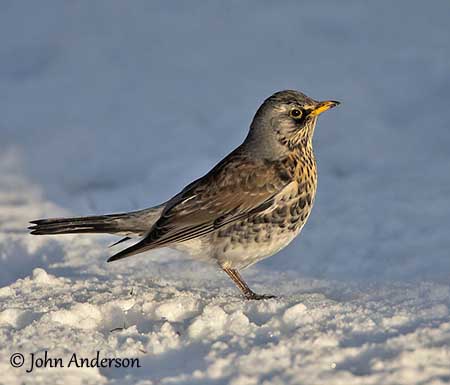
The juvenile resembles adult but it is more uniform brownish-grey on the upperparts, with buff streaks on scapulars. On the underparts, the pattern is stronger and darker than in adults with spots instead of streaks, or in chevrons.
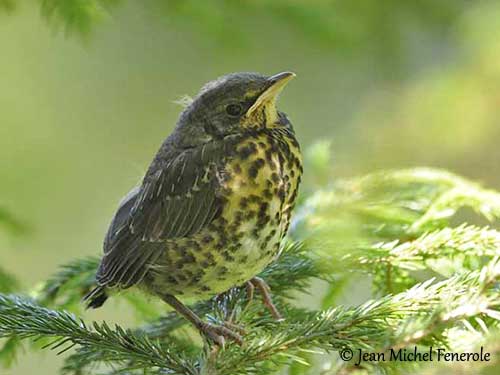
RANGE:
The Fieldfare breeds in Iceland and N and C Europe, E to C Siberia and NW China (Tien Shan). Outside the breeding season, it can be found in W and S Europe, N Africa and SW Asia.
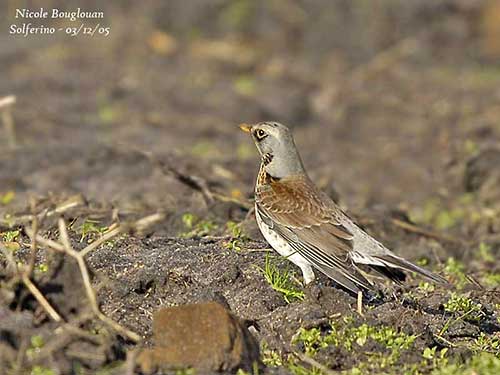
HABITAT:
The Fieldfare breeds in boreal forests with pines (Pinus) and birches (Betula), in scrub, clearings, parks and large gardens, and locally in open tundra. It generally uses trees for nesting and roosting.
Outside the breeding season, it can be found in open farmland often with trees and hedgerows. It favours permanent grassy areas for foraging, but it also frequents winter cereals, stubble and bare grounds.
Small numbers may extend beyond the tree-line where they occur in alpine heathland and tundra scrub. The highest known breeding site was at 1300 metres of elevation in E Alpes in Europe.
They roost communally in trees, shrubs, reeds and hedgerows, often with other Turdidae.
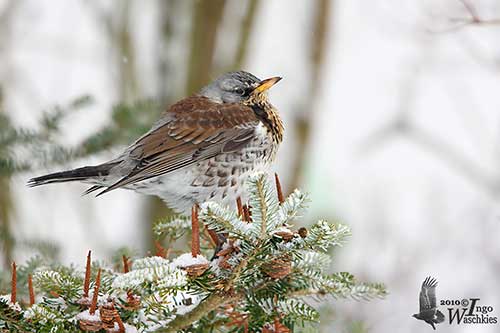
CALLS AND SONGS: SOUNDS BY XENO-CANTO
The Fieldfare in flight gives a soft, chuckling chatter “chuck-chuck-chuck… chack-chack-chack” interspersed with whistles and squeaks. We can also hear a thin “seeh” or “tsree”. The alarm call is a sharp “chetchetchetje” or a high-pitched “trt-trt-trrrt-trrt” increasing and directed at the intruder.
The song is a weak, squeaky, unmusical warbling, interspersed with chuckling and whistling phrases. It often starts with “chack” notes followed by twittering notes, or a slow “took-took-tcheree-cherri-weeoo” interspersed with “chack” notes.
The song is given from tree or in flight. The roosting birds utter a low subsong in chorus with others. The flight song is part of courtship display. During the breeding season, the full song is only given in the morning and the evening.
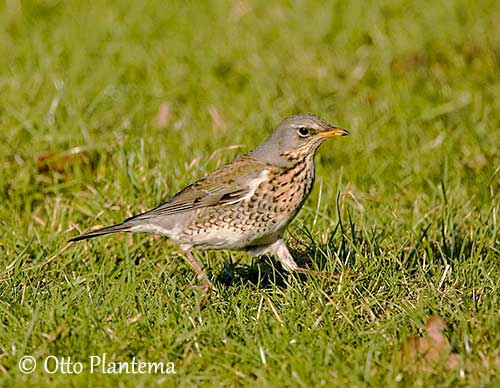
BEHAVIOUR IN THE WILD:
The Fieldfare forages in small to large flocks on open ground. It probes in soft hearth, digs into rotting fruit and vegetation.
Its diet includes insects such as ants, beetles, bugs, crickets, flies, moth larvae… It also takes spiders, earthworms and snails.
The plant material includes fruit and seeds of alder, apples fallen to the ground, berries from several plant species and grain. In spring, it may take shoots and buds.
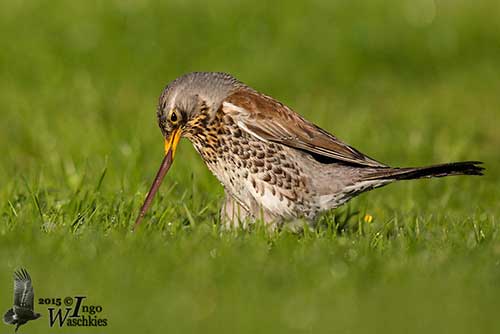
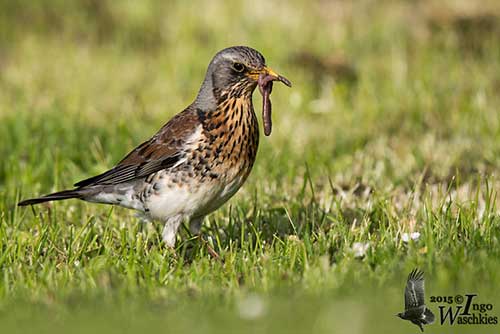
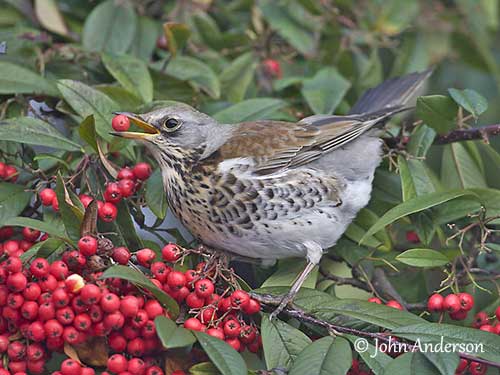
On the ground, the Fieldfare has an upright stance. Head and neck are held high, the tail is horizontal and the wings are drooped at sides of rump. It moves by rapid hopping or bounding gait.
When disturbed, it reaches rapidly the tops of nearby trees and bushes.
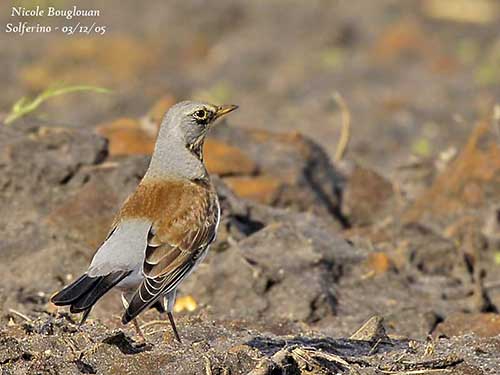
During the breeding season, the Fieldfare nests semi-colonially in Scandinavia (5-50 pairs) and more often as solitary nester in the south of the breeding range.
The pair forms during winter and the first copulations occur in late March. They are monogamous for a single season, but extra-pair copulations are probably common. They are territorial and defend strongly their territory. Usually, the pairing is rapid with simple courtship displays including the flight song.
The Fieldfare is known for its defence behaviour against predators. From some observations, it is able to ram magpies and jays in flight, and escorts them away from the colonies.
But the most typical defence consist of well-aimed defecation directed at the intruder, and this is usually a communal mobbing tactic. Raptors and crows do not like to be plastered with sticky faeces involving losing the power of flight.
The Fieldfares are affected by heavy predation on eggs and chicks at nest. The whole brood is often destroyed and the thrushes perform various distraction displays and strong nest defence. They also favour more concealed nest-sites.
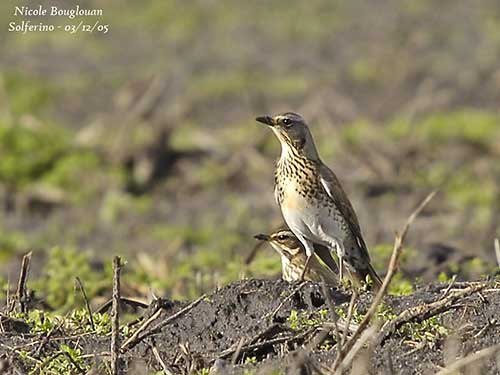
The Fieldfare is migratory. However, according to weather conditions and food availability, a significant proportion of the breeding population remains in the country as they do in Norway.
The young of the year move in July/August, while adults move mainly between September and November. They migrate both by day and by night, in small groups or larger loose flocks. And again, the migration and the wintering areas depend largely on the weather. They move further south if the weather conditions are harsh in more norther breeding areas.
The male usually returns to the breeding grounds a week before the female, between late February and late March in Germany, and between mid-April and mid-May in Norway.
Usually, the Fieldfare has leisurely, gently undulating flight. But over longer distances, the flocks fly high in the air with swift, strong, direct flight and rapid wingbeats. Flocks have been tracked by radar at 3270 metres above the ground.
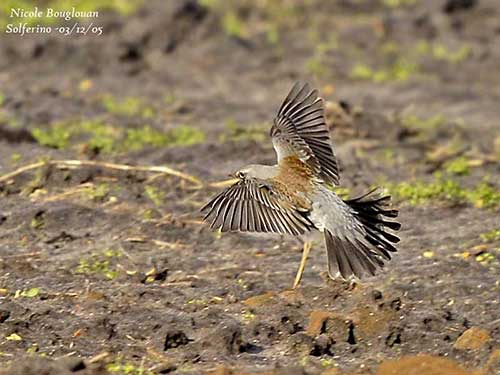
REPRODUCTION OF THIS SPECIES:
The breeding season occurs between early April and late August. In the northernmost areas, it is related to the disappearance of the snow cover.
The Fieldfare can be markedly or loosely colonial with 5 to 50 pairs nesting together, usually in trees, often within 10 metres from the ground, but occasionally up to 20 metres. The nests can be 5-30 metres apart and there are rarely two nests in the same tree.
The cup-shaped nest is a bulky structure of grass, twigs, leaves and roots cemented together with mud, and lined with finer grasses and horse hair. It is placed in tree-fork or against the trunk, exceptionally in rocks or on the ground, usually at forest edge.
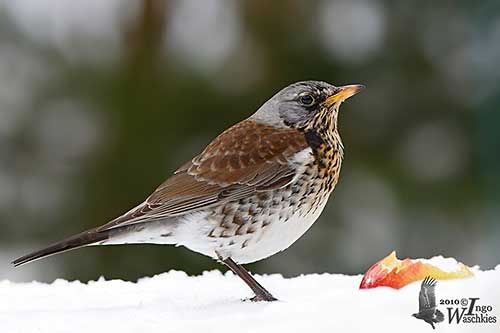
The female lays 3-7 pale blue eggs with brownish markings. She incubates during 10-14 days. The young fledge 12-15 days after hatching, but they still depend on parents for food during one month. This species may produce two broods per year, but only one in some areas.
The adults undergo moult between July and September, while the juveniles undergo moult in August and September, completed before the autumn migration.
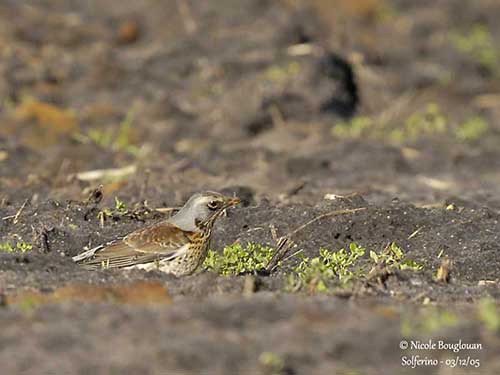
PROTECTION / THREATS / STATUS:
The Fieldfare has wide range in which it is common. This species is not threatened with a global population estimated to number about 44,700,000/96,000,000 individuals. This population appears stable and even increasing in Europe in past 100 years, and no known decline elsewhere in the range.
The European population is estimated at 42,000,000/72,000,000 individuals (2004).
The Fieldfare is currently evaluated as least Concern.
